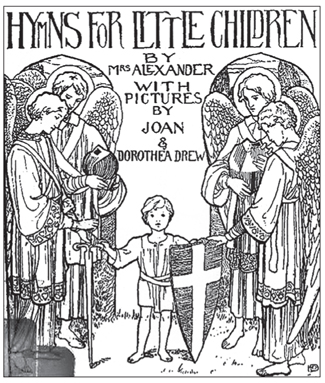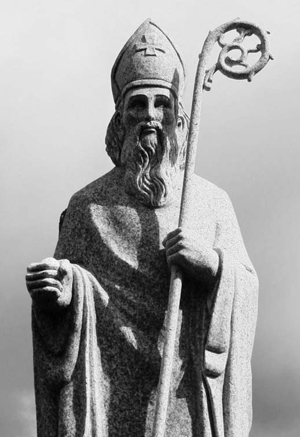Why was the Partridge in the Pear Tree? (13 page)
Read Why was the Partridge in the Pear Tree? Online
Authors: Mark Lawson-Jones

It is much more likely that Mohr simply wanted to produce a new Christmas carol, simple and easily sung, to the accompaniment of a guitar. Gruber’s composition reflects the rural folk music that would have been common at the time. The original manuscript has been lost. However, the earliest, clearly in Mohr’s handwriting, dates back to around 1820.
The man who translated ‘Stille Nacht’ into ‘Silent Night’ was John Freeman Young, whilst assigned to Trinity Church, New York City. Young was born in 1820, two years after the first public performance of the carol. Converting to the Anglican Church from his Methodist background, he attended Theological Seminary, eventually starting ministry in Jacksonville, Florida. At the time he was one of only two paid clergy in the state. He moved to various posts in the South – Texas, Mississippi and Louisiana – until in 1855 he arrived in New York City. This was a busy time in his life; he enjoyed church architecture, hymnology and translating famous hymns from various churches, including ‘Silent Night’, in 1859, which appeared in a sixteen-page pamphlet entitled Carols for Christmastide. In 1867, the Revd Young was consecrated as Bishop of Florida.
There is a fourth verse wrongly attributed to Bishop Young:
Silent night, Holy night,
Wondrous star, lend thy light
With the angels let us sing
Alleluia to our King
Christ the Saviour is here,
Jesus the Saviour is here!
This verse remains anonymous, although those who love this hymn are still hoping that a manuscript will appear to confirm the identity of the person who added the verse. To this day, ‘Silent Night, Holy Night’ remains a firm favourite and regularly appears at the top of favourite Christmas Carol polls. Since being written, set to music and performed, it has grown in popularity to become a truly universal carol.
In the chapter on ‘O Come All Ye Faithful’, we looked at the carols sung in the trenches during the 1914 First World War ceasefire and ‘Silent Night, Holy Night’ was reportedly sung simultaneously in English, French and German according to Stanley Weintraub on the 1914 truce
Silent Night: The Remarkable Christmas Truce of 1914
(2001). It has been performed and recorded by many, among them; Johnny Cash, Elvis Presley, Stevie Nicks, Bing Crosby, Tori Amos, Christina Aguilera, Westlife and most recently Susan Boyle and Annie Lennox. It has been rearranged, parodied and performed by choirs, orchestras and buskers!

Once in Royal David's City
Once in royal David's city,
Stood a lowly cattle shed,
Where a mother laid her Baby,
In a manger for His bed:
Mary was that mother mild,
Jesus Christ, her little Child.
He came down to earth from heaven,
Who is God and Lord of all,
And His shelter was a stable,
And His cradle was a stall:
With the poor, and mean, and lowly,
Lived on earth our Saviour holy.
For He is our childhood's pattern;
Day by day, like us, He grew;
He was little, weak, and helpless,
Tears and smiles, like us He knew;
And He cares when we are sad,
And he shares when we are glad.
And our eyes at last shall see Him,
Through His own redeeming love;
For that Child so dear and gentle,
Is our Lord in heaven above:
And He leads His children on,
To the place where He is gone.
For millions of listeners all over the world, Christmas begins with the clear treble voice of a Cambridge choirboy. Every year since 1919 this has been the opening hymn in the service of Nine Lessons and Carols, broadcast from King's College chapel on Christmas Eve. The hymn itself is much older than the service, written for a collection of hymns more than half a century earlier.
The hymn writer, Cecil Frances Alexander, was born in early April 1818, the second daughter of Major John Humphries of County Tyrone, Ireland. As a child, she started to write religious verse and was strongly influenced by John Keble and other members of the Oxford Movement; many years later Keble himself would edit one of her anthologies. Many hymn writers of the day felt the same affinity to the Oxford Movement, who were high church Anglicans who argued for the reinstatement of traditional liturgy, symbolism and theology. She would have been in good company with her peers, John Mason Neale, who wrote âGood King Wenceslas', and Christina Rossetti, who wrote âIn the Bleak Midwinter', all of whom were influenced by the traditional church and the Oxford Movement.
In 1850, when she married the Revd William Alexander, the thirty-two-year-old Cecil Frances (Fanny) Humphries was already a published hymn writer, with her
Hymns for Little Children
published two years earlier. This collection included the favourite âAll Things Bright and Beautiful', âThere is a Green Hill Far Away', and the carol âOnce in Royal David's City', written to help children imagine the circumstances in which Jesus Christ was born, and to illustrate the words of the Apostles Creed, an early statement of Christian belief, probably written down by St Ambrose in around
AD
390.

Hymns for Little Children
by C.F. Alexander (1848). This cover from the 1903 edition with artwork by Joan and Dorothea Drew.
When they married, Revd William Alexander, who had been educated in Brasenose College, Oxford, held several parishes before becoming the Bishop of Derry and Raphoe in 1867. He was well regarded for his preaching and theological insights; in 1871 he was saddened to be the last bishop to sit in the House of Lords before Disestablishment under the Irish Churches Act. In 1896 he was elevated to the most senior Church position when he became the Archbishop of Ireland.
On the day of the Disestablishment of the Church of Ireland, a hymn written by Cecil Alexander was sung in her husband's cathedral, which included the controversial verse:
Look down, Lord of heaven on our desolation,
Fallen, fallen, fallen is now our Country's crown,
Dimly down the New year as a Churchless nation,
Mammon and Amalek tread our borders down.
Alexander continues to this day to attract controversy for her lyrics. Her conservative values on the place of the poor in society, which was by no means extraordinary at the time, has resulted in the following verse from âAll Things Bright and Beautiful' being removed from most hymn books:
The rich man in his castle,
The poor man at his gate,
God made them, high and lowly,
And order'd their estate.
Even without this verse, the hymn remains a favourite for many occasions including weddings and funerals.
Alexander held with the common belief amongst middle-class Victorians that âthe poor were improvident, they wasted any money they had on drink and gambling' and that âGod had put people in their place in life and this must not be interfered with because the life after death was more important'. Nevertheless, she was extremely generous and donated all payments for her poetry to Derry and Raphoe Diocesan Institution for the Deaf and Dumb, which was founded in 1846 in Strabane.
Cecil Frances Alexander wrote more than 400 hymns during her life, including what could be arguably said to be the most famous carol of all time, âOnce in Royal David's City'. Her book for children was in its 69th edition by the late nineteenth century, and throughout the world people were familiar with her work.
Later in her life, she translated the sixth-century prayer to be said before a journey, traditionally attributed to St Patrick. The popular âSt Patrick's Breastplate' begins with the old Irish:
Atomriug indiu
niurt trÃun
togairm TrÃndóite
cretim treodatad
foÃsitin oendatad
i nDúilemon dáil.

Statue of St Patrick.
Alexander translated and created a metrical version of the prayer to be used as a hymn. The first verse begins:
Christ be with me, Christ within me, Christ behind me, Christ before me,
Christ beside me, Christ to win me, Christ to comfort and restore me.
Christ beneath me, Christ above me, Christ in quiet, Christ in danger,
Christ in hearts of all that love me, Christ in mouth of friend and stranger.
They were married for forty-five years, half of which was lived in Derry. She died in Dublin in 1895, and is buried in the City Cemetery in Londonderry.

Good King Wenceslas
Good King Wenceslas looked out
On the feast of Stephen
When the snow lay round about
Deep and crisp and even
Brightly shone the moon that night
Though the frost was cruel
When a poor man came in sight
Gath’ring winter fuel
‘Hither, page, and stand by me
If thou know’st it, telling
Yonder peasant, who is he?
Where and what his dwelling?’
‘Sire, he lives a good league hence
Underneath the mountain
Right against the forest fence
By Saint Agnes’ fountain.’
‘Bring me flesh and bring me wine
Bring me pine logs hither
Thou and I will see him dine
When we bear him thither.’
Page and monarch forth they went
Forth they went together
Through the rude wind’s wild lament
And the bitter weather
‘Sire, the night is darker now
And the wind blows stronger
Fails my heart, I know not how,
I can go no longer.’
‘Mark my footsteps, my good page
Tread thou in them boldly
Thou shalt find the winter’s rage
Freeze thy blood less coldly.’
In his master’s steps he trod
Where the snow lay dinted
Heat was in the very sod
Which the Saint had printed
Therefore, Christian men, be sure
Wealth or rank possessing
Ye who now will bless the poor
Shall yourselves find blessing.
Wenceslas Square is situated in Prague, the capital of the Czech Republic. Much has happened there; historically it was used as a horse market in the fourteenth century when the Bohemian King Charles IV founded the New Town of Prague. It was named Wenceslas Square in 1848. In 1918, a proclamation of independence was read there. Mass demonstrations were held in the square by the Nazis and in 1945, from the 5-8 May, many of the buildings around the square were damaged as the Czech Resistance attempted to gain control just before the Red Army arrived at the end of the Second World War in Europe. In 1969 a student, Jan Palach, set fire to himself to protest about the invasion of Czechoslovakia by the Soviet Union in 1968. In 1989, during the ‘Velvet Revolution’ (known as the ‘Gentle Revolution’ in the Czech Republic), many demonstrations were held there, leading to democratic elections in 1990. Wenceslas Square and Wenceslas its’ namesake are important to the people of the Czech Republic, and indeed to the world, as it is now a
UNESCO
World Heritage Site, but who was he? Was Wenceslas a king, a duke or a saint? Why does his statue dominate the square, and why has he a place that is foremost in the national life of the Czech Republic named after him?
